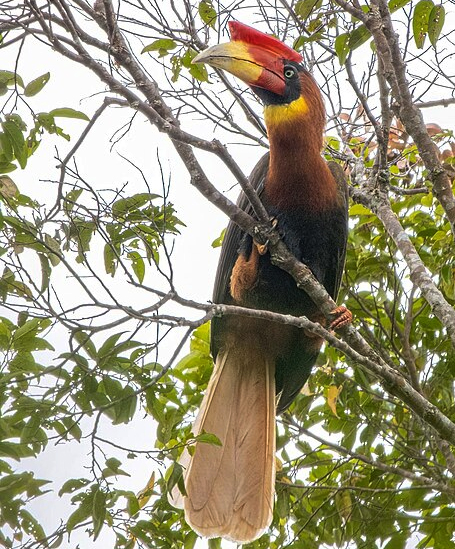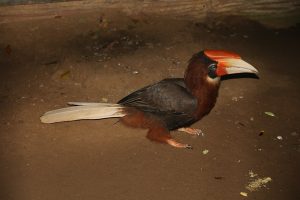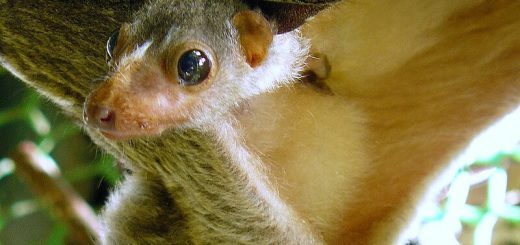Rufous Hornbill – A Jewel of the Skies

The Philippine Rufous Hornbill (Buceros hydrocorax), locally known as Kalaw, is a majestic and striking bird native to the islands of the Philippines. With its vibrant plumage, distinct horn-shaped casque, and commanding presence, this hornbill is a true symbol of the country’s rich biodiversity. However, despite its beauty and importance, the Philippine Rufous Hornbill faces significant challenges to its survival. In this blog, we’ll explore what makes this species so unique, the ecological roles it plays, and the conservation efforts aimed at saving it from extinction.
A Closer Look at the Philippine Rufous Hornbill
Physical Features
The Philippine Rufous Hornbill is a large, striking bird, with adult males measuring about 90 cm (35 inches) in length. Their most notable feature is their dramatic, curved casque, a large, helmet-like structure on the top of their beak, which is particularly prominent in males. The casque serves as both a visual cue for attracting mates and a resonance chamber that amplifies the bird’s calls.
Their plumage is equally eye-catching, with a combination of white, black, and rufous (reddish-brown) colors. The body is predominantly black, with a white underbelly and distinct rufous coloration on the wings and tail. Their large size and striking colors make them one of the most recognizable hornbill species in the Philippines.
Kalaw Habitat and Distribution
The Philippine Rufous Hornbill is found primarily in the lowland forests and montane regions of the islands of Mindanao and nearby smaller islands. They prefer dense tropical rainforests, which provide the necessary food sources and nesting sites. As an arboreal bird, it relies heavily on tall trees for roosting and foraging. These birds are typically seen in pairs or small family groups and have a somewhat solitary nature.
However, habitat loss due to deforestation has significantly reduced their natural range, and today, these hornbills are considered endangered.

Rufous Hornbill in Cebu zoo.
© Creative Commons | Author: Øyvind Holmstad
Ecological Importance
Hornbills, including the Philippine Rufous Hornbill, play a vital role in their ecosystem. They are primarily frugivores (fruit eaters), which means they help in seed dispersal across large distances. By consuming fruits and berries from various trees and then flying to other locations, they effectively spread seeds that would otherwise be confined to a smaller area. This helps maintain the genetic diversity of plant species and promotes the regeneration of the forest.
Moreover, hornbills also contribute to controlling insect populations by feeding on insects, small animals, and even some small reptiles. In doing so, they help maintain a balanced ecosystem where various species can thrive.
The Threats Facing the Philippine Rufous Hornbill
Despite its ecological importance, the Philippine Rufous Hornbill is facing an uphill battle for survival. Several threats are contributing to the decline of their population:
Deforestation – The clearing of forests for logging, agriculture, and infrastructure development is the most significant threat to the Philippine Rufous Hornbill. As the forests shrink, so does the bird’s habitat, and it becomes increasingly difficult for them to find suitable nesting sites and food.
Poaching – Hunting and trapping for the pet trade have also contributed to the bird’s dwindling numbers. Though this issue is more prominent for other hornbill species, the Philippine Rufous Hornbill is also at risk.
Loss of Food Sources – The destruction of forests not only eliminates habitat but also reduces the availability of the fruits and other plant matter that the hornbills depend on for sustenance.
Climate Change – Like many species, the Philippine Rufous Hornbill is also vulnerable to the impacts of climate change, which can alter the availability of food, water, and suitable nesting sites.
Conservation Efforts
The Philippine Rufous Hornbill is currently classified as Endangered on the International Union for Conservation of Nature (IUCN) Red List. While the situation is dire, there are concerted efforts underway to protect and conserve this incredible species.
Protected Areas
The Philippine government has established several protected areas and national parks in the hornbill’s range, where logging and other forms of habitat destruction are restricted. These efforts aim to safeguard the remaining forests and create safe havens for the hornbills and other endangered species.
Local Conservation Initiatives
Local conservation groups, often in collaboration with international organizations, are working on several fronts to protect the Philippine Rufous Hornbill. These include:
Community-based conservation programs – Engaging local communities in the protection of their natural resources, promoting sustainable livelihoods, and educating people about the importance of the hornbill and the forests.
Habitat restoration projects – Reforestation efforts and tree planting campaigns to restore areas that have been cleared of trees.
Anti-poaching measures – Strengthening patrols and increasing penalties for the illegal hunting and capture of hornbills.
Research and Education
Ongoing research into the biology, behavior, and ecology of the Philippine Rufous Hornbill is crucial to understanding the species’ needs and developing more effective conservation strategies. Educational programs aimed at raising awareness about the plight of hornbills are also key in mobilizing public support for their protection.
How You Can Help
While the Philippine Rufous Hornbill’s future remains uncertain, there are ways individuals and organizations can help in conservation efforts:
Support local NGOs and conservation projects: Many organizations focus on protecting hornbills and their habitats. Consider donating to or volunteering with these groups.
Practice responsible ecotourism: If visiting the Philippines, choose ecotourism operators who are committed to wildlife conservation and sustainable practices.
Spread awareness: Educate others about the importance of conserving endangered species like the Philippine Rufous Hornbill and advocate for policies that protect biodiversity.
The Philippine Rufous Hornbill is not just an emblem of the Philippines’ natural beauty, but also a critical component of the tropical ecosystems where it lives. By continuing to raise awareness, protect its habitats, and support conservation efforts, we can help ensure that future generations will continue to hear the distinctive calls of this magnificent bird echoing through the forests of the Philippines.
References:
https://en.wikipedia.org/wiki/Rufous_hornbill










